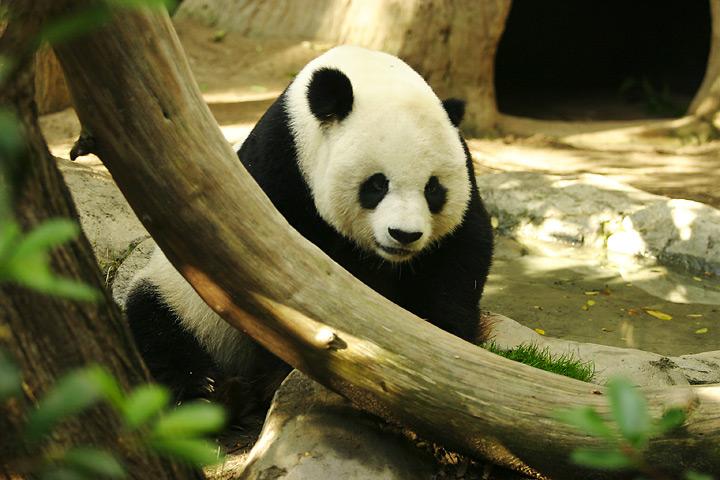Giant Panda (Ailuropoda melanoleuca) - Wiki Giant Panda
From Wikipedia, the free encyclopedia
[Photo] Gao Gao, an adult male giant panda at San Diego Zoo. Photo by Aaron Logan. Source: Lightmatter http://www.lightmatter.net/gallery/Animals/panda
The giant panda (Ailuropoda melanoleuca "black-and-white cat-foot") is a mammal classified in the bear family, Ursidae, native to central and southern China.
The panda's main food is bamboo, but they may eat other foods such as honey, eggs, fish, and yams. Easily recognizable through its large, distinctive black patches around the eyes, ears and on its rotund body, the giant panda is an endangered animal: an estimated 1,600 pandas live in the wild and some 188 were reported to live in captivity at the end of 2005, twenty of which are found outside of China. However, reports show that the panda numbers in the wild are on the rise.
General information
The giant panda has a very distinctive black-and-white coat, and adults measure around 1.5m long and around 75cm tall at the shoulder. Males can weigh up to 115 kg (253 pounds). Females are generally smaller than males, and can occasionally weigh up to 100 kg (220 pounds). Giant pandas live in mountainous regions, such as Sichuan, Gansu, Shaanxi, and Tibet. While the Chinese dragon has been historically a national emblem for China, since the latter half of the 20th century, the panda has also become an informal national emblem for China, and its image is found on many Chinese gold coins.
Despite being taxonomically a carnivore, the panda has a diet that is primarily herbivorous, which almost exclusively consists of bamboo. This is an evolutionarily recent adaptation, or perhaps just a very awkward one; pandas lack the proper enzymes to digest bamboo efficiently, and thus derive little energy and little protein from it.
While primarily herbivorus, the panda still retains decidedly ursine teeth, and will readily eat meat, fish, and eggs when available, but their sluggish speeds, a consequence of their mainly bamboo diet, ensure that these more energy-rich foods are seldom available to them outside of captivity. In captivity, zoos typically maintain the pandas' bamboo diet, though some will provide specially formulated biscuits or other dietary supplements.
Unlike most bears, but like most subtropical mammals, the giant panda does not hibernate.
For many decades the precise taxonomic classification of the panda was under debate as both the giant panda and the distantly related red panda share characteristics of both bears and raccoons. However, genetic testing suggests that giant pandas are true bears and part of the Ursidae family, though they differentiated early in history from the main ursine stock. The giant panda's closest bear relative is the Spectacled Bear of South America. (Disagreement remains about whether or not the red panda belongs in Ursidae; the raccoon family, Procyonidae; or in its own family, Ailuridae.)
Giant pandas are an endangered species, threatened by continued habitat loss and by a very low birthrate, both in the wild and in captivity. Poaching is uncommon; killing a panda was punishable in China by death until a 1997 law changed the penalty to 20 years imprisonment. The giant panda has an unusual paw, with a "thumb" and five fingers; the "thumb" is actually a modified sesamoid bone, which helps the panda to hold the bamboo while eating. Stephen Jay Gould wrote an essay about this, then used the title The Panda's Thumb for a book of essays concerned with evolution and intelligent design. The giant panda has a short tail, approximately 15 cm long.
The giant panda has long been a favorite of the public, at least partly on account of the fact that the species has an appealing baby-like cuteness that makes it seem to resemble a living teddy bear. The fact that it is usually depicted reclining peacefully eating bamboo, as opposed to hunting, also adds to its image of innocence. Though the giant panda is often assumed docile because of their cuteness, they have been known to attack humans, usually assumed to be out of irritation rather than predatory behavior.
Giant pandas can usually live to be 20-30 years old while living in captivity.
Until recently, scientists thought giant pandas spent most of their lives alone, with males and females meeting only during the breeding season. Recent studies paint a different picture, in which small groups of pandas share a large territory and sometimes meet outside the breeding season.
http://en.wikipedia.org/wiki/Giant_Panda
| The text in this page is based on the copyrighted Wikipedia article shown in above URL. It is used under the GNU Free Documentation License. You may redistribute it, verbatim or modified, providing that you comply with the terms of the GFDL. |
